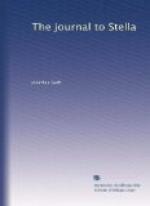Previous editions of the Journal have been but slightly annotated. Swift’s letters abound with allusions to people of all classes with whom he came in contact in London, and to others known to Esther Johnson in Ireland; and a large proportion of these persons have been passed over in discreet silence by Sir Walter Scott and others. The task of the annotator has, of course, been made easier of late years by the publication of contemporary journals and letters, and of useful works of reference dealing with Parliament, the Army, the Church, the Civil Service, and the like, besides the invaluable Dictionary of National Biography. I have also been assisted by a collection of Ms. notes kindly placed at my disposal by Mr. Thomas Seccombe. I have aimed at brevity and relevance, but it is hoped that the reader will find all the information that is necessary. Here and there a name has baffled research, but I have been able to give definite particulars of a very large number of people— noblemen and ladies in society in London or Dublin, Members of Parliament, doctors, clergymen, Government officials, and others who have hitherto been but names to the reader of the Journal. I have corrected a good many errors in the older notes, but in dealing with so large a number of persons, some of whom it is difficult to identify, I cannot hope that I myself have escaped pitfalls.
G. A. A.
INTRODUCTION.
When Swift began to write the letters known as the Journal to Stella, he was forty-two years of age, and Esther Johnson twenty-nine. Perhaps the most useful introduction to the correspondence will be a brief setting forth of what is known of their friendship from Stella’s childhood, the more specially as the question has been obscured by many assertions and theories resting on a very slender basis of fact.
Jonathan Swift, born in 1667 after his father’s death, was educated by his uncle Godwin, and after a not very successful career at Trinity College, Dublin, went to stay with his mother, Abigail Erick, at Leicester. Mrs. Swift feared that her son would fall in love with a girl named Betty Jones, but, as Swift told a friend, he had had experience enough “not to think of marriage till I settle my fortune in the world, which I am sure will not be in some years; and even then, I am so hard to please that I suppose I shall put it off to the other world.” Soon afterwards an opening for Swift presented itself. Sir William Temple, now living in retirement at Moor Park, near Farnham, had been, like his father, Master of the Irish Rolls, and had thus become acquainted with Swift’s uncle Godwin. Moreover, Lady Temple was related to Mrs. Swift, as Lord Orrery tells us. Thanks to these facts, the application to Sir William Temple was successful, and Swift went to live at Moor Park before the end of 1689. There he read to Temple, wrote for him, and kept his accounts,




